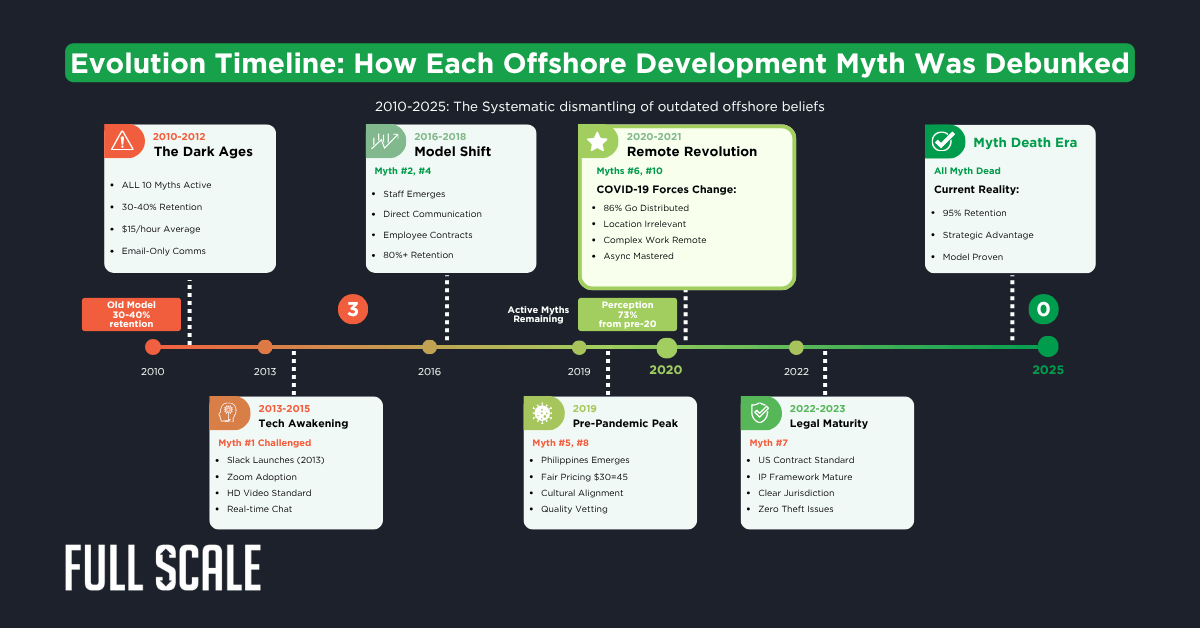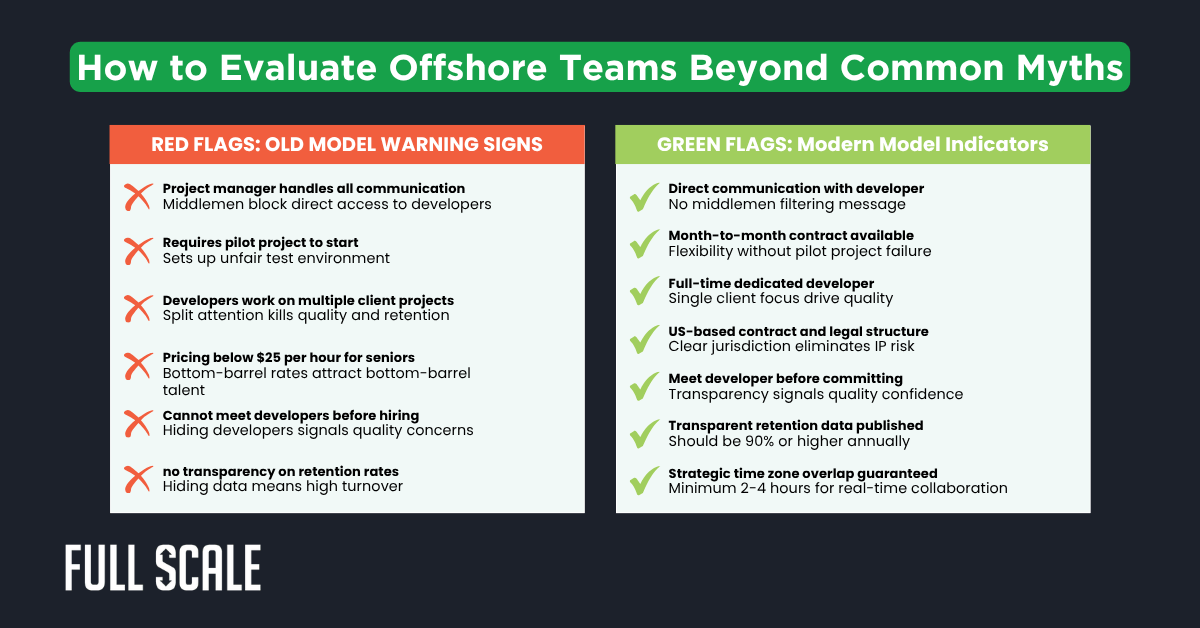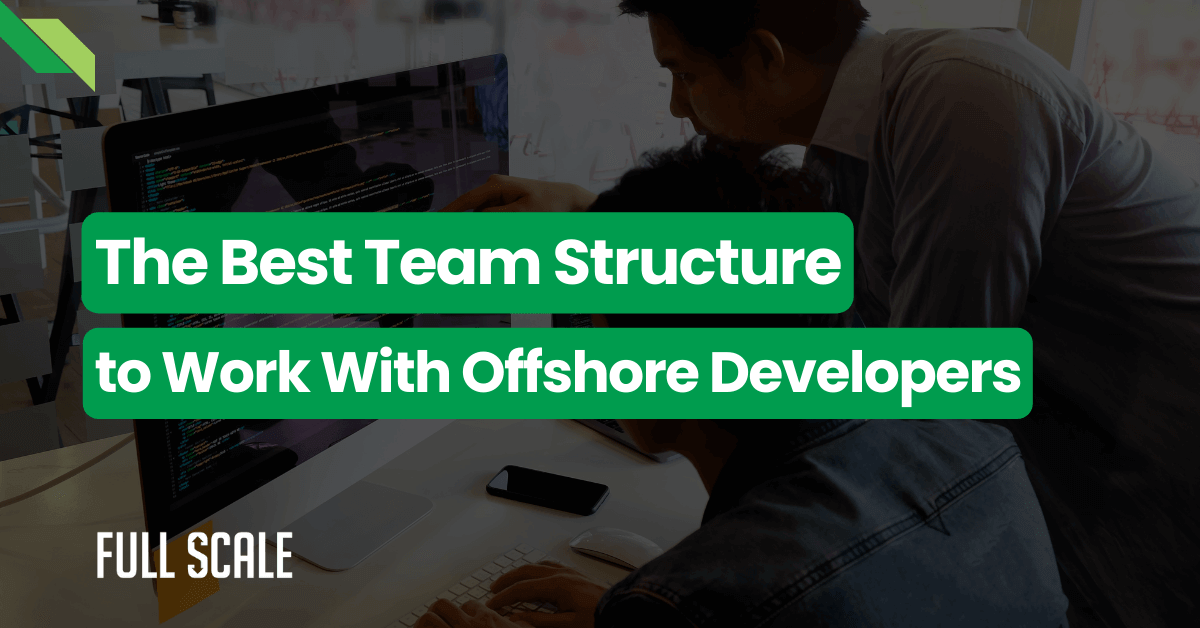Last Updated on 2025-10-23
Your CTO friends are giving you terrible advice about offshore development. It’s costing you senior talent at 60% savings.
Their horror stories come from 2010-era outsourcing nightmares that don’t exist anymore. The offshore development myths they keep repeating are based on models we fixed years ago.
Here’s what actually changed and why their CTO’s advice is obsolete.
What You’ll Learn in This Article
Quick Answer: Is offshore development reliable in 2025?
Yes, when using modern staff augmentation models. The 2010 problems like poor communication, no control, and high turnover are solved through direct team integration, strategic timezone selection, and proper legal structures. Companies now achieve 95% retention rates with offshore teams according to our analysis of 800+ placements.
Why CTO Advice About Offshore Development Myths Persists
Walk into any CTO meetup and mention offshore development. You’ll hear the same horror stories on repeat.
Bad communication. Zero control. Terrible code quality. Developers who disappear after three months.
Here’s the problem with that CTO advice. Most of those experiences happened over a decade ago.
The offshore development model they warned you about was project-based outsourcing through agencies. Multiple middlemen stood between you and the actual developers. Communication happened through email and weekly calls, if you were lucky.
They experienced 12-hour timezone gaps with no overlap. Contractors jumped between projects every few months. Nobody vetted developers properly because everyone competed on price alone.
According to Gartner’s IT Services Market Trends Report 2024, published in June 2024, 73% of negative offshore perceptions stem from pre-2020 experiences. The industry evolved, but the advice didn’t update.
The model that burned your CTO friends doesn’t exist anymore. At least it shouldn’t if you know where to look.
Calculate the Real Cost of Offshore Development Myths
Before we bust the offshore development myths, see what outdated CTO advice is actually costing you. This calculator compares 2010 outsourcing against modern staff augmentation.
Offshore Model Cost Calculator
2010 Outsourcing Model
2025 Staff Augmentation
The calculator shows real costs, including turnover and communication overhead. Old outsourcing models hide these expenses until you’re already committed. Modern staff augmentation eliminates most hidden costs through better retention and direct communication.
10 Offshore Development Myths That Need to Die in 2025
Let’s kill the offshore development myths one by one. Each myth comes from real CTO advice based on outdated experiences.
The pattern is always the same. They tried offshore in 2010 through the wrong model. It failed exactly how bad models fail. Now they warn everyone away from something that works completely differently.
Quick Myth Summary
- Offshore developers can’t communicate effectively
- You lose control with offshore teams
- Offshore always means poor code quality
- High turnover is unavoidable with offshore
- Offshore is only for cost-cutting, not quality
- Time zones make collaboration impossible
- IP protection is too risky offshore
- Cultural differences kill team dynamics
- Always start with a pilot project
- Offshore only works for simple work
Offshore Development Myth #1: Communication Always Fails
Your CTO friend remembers emailing developers and waiting 24 hours for responses. Video calls were rare. English skills ranged from poor to worse.
That was the 2010 outsourcing model with rushed hiring and zero cultural training. Communication happened through project managers who filtered everything.
Modern offshore teams use the exact same tools as your US developers. Slack for instant messaging. Zoom for face-to-face standups. Jira for project tracking.
We only hire English-fluent developers who can communicate directly with your team. No middlemen translating requirements. Our clients schedule daily standups during the 2-4 hour timezone overlap with Philippines-based teams.
The communication quality matches or exceeds what you get from remote US developers. Because the tools and processes are identical.
Offshore Development Myth #2: You Lose All Control
The old model kept clients away from actual developers on purpose. Agencies wanted to protect their margin by controlling all communication.
You submitted requirements to a project manager. Weeks later, you got whatever the developers built. No visibility into progress.
Staff augmentation flips this completely. Your offshore developers report directly to you, not an agency. You manage them exactly like local team members.
We’ve helped 60+ tech companies build offshore teams that integrate seamlessly into existing workflows. CTOs tell us they forget which developers are offshore versus onshore.
Offshore Development Myth #3: Quality Is Always Poor
Bottom-barrel pricing in 2010 attracted junior developers with minimal experience. Your CTO friend paid $15 per hour and got $15 per hour quality.
Quality depends on your vetting process, not developer geography. Senior developers exist everywhere when you know how to find them.
We maintain a pool of 300+ pre-vetted senior developers. Every candidate goes through technical screening and code challenges. Our developers handle complex work like AI integration and microservices architecture.
The 95% client retention rate proves the quality matches expectations. Companies don’t stick with developers who ship bad code.
Offshore Development Myth #4: Turnover Can’t Be Avoided
Old outsourcing treated developers as disposable contractors. They jumped between projects every 3-6 months, chasing better rates. No benefits. No career growth.
Our developers are full-time employees with benefits and career paths. They work for one client long-term, not multiple projects simultaneously.
According to McKinsey’s Global Tech Talent Survey 2024, published in March 2024, companies using employee-based offshore models achieve 85-95% annual retention rates. This compares to just 30-40% retention with traditional contractor-based outsourcing.
Clients build institutional knowledge with teams that understand their codebase deeply. That’s impossible with constant turnover.
Offshore Development Myth #5: It’s Only About Cutting Costs
The race-to-bottom pricing model reinforced the cheap equals bad perception. Your CTO friend was selected based purely on price.
Modern offshore provides access to senior talent at fair market rates. We charge $30-45 per hour for developers who match US mid-level capabilities. That’s 60% savings compared to US rates, not 90%.
Competitive pricing attracts and retains quality developers who could work anywhere. This pricing also signals to clients that quality matters.
Offshore Development Myth #6: Timezones Kill Collaboration
India and Eastern Europe teams worked 8-12 hours offset from US time. Zero overlap meant purely asynchronous communication.
Strategic timezone selection changes everything. The Philippines operates 12-16 hours ahead of US time, creating 2-4 hour overlap windows.
Schedule your standups at 8 am Pacific and it’s 11 pm in Cebu. Developers are online and available for real-time discussion. The remaining async time actually helps productivity.
Offshore Development Myth #7: IP Theft Is Inevitable
Foreign contracts created legitimate concerns about IP enforcement. Your CTO friend heard stories about stolen code and zero recourse.
We use US-based contracts exclusively. You sign with a US entity. US law applies. US courts have jurisdiction.
Standard IP assignment clauses transfer all rights to you. Zero IP issues across 60+ client relationships because the legal structure eliminates the risk.
Offshore Development Myth #8: Cultural Gaps Can’t Be Bridged
Some regions have vastly different work cultures and communication styles. Those differences created real friction in early offshore experiments.
Cultural alignment varies significantly by country. Philippines has strong US cultural ties from shared history. English is an official language. Direct communication style matches US tech culture.
We provide cultural onboarding for both sides. But the baseline alignment makes integration much smoother than regions with bigger cultural gaps.
Offshore Development Myth #9: Pilot Projects Reduce Risk
This sounds like smart risk management advice. Test with a small project before committing to a full team.
Pilot projects set teams up to fail. You assign non-critical work. Provide minimal resources. Don’t fully integrate the team. Then you evaluate performance based on an unfair test.
We offer month-to-month contracts instead. Hire developers properly. Integrate them fully. Cancel anytime if it’s not working. Proper integration from day one shows 3x higher success rates in our data.
Offshore Development Myth #10: Complex Work Needs Proximity
Pre-2020, physical proximity supposedly mattered for complex work. COVID proved that myth wrong for everyone.
Our developers specialize in cutting-edge technologies. React and Python experts. AI and machine learning engineers. Enterprise system architects. They build core product features, not maintenance tasks. According to GitLab’s 2024 Remote Work Report, 86% of technology companies now operate fully distributed teams across multiple time zones. Remote work is remote work regardless of geography.

What Changed Since These Offshore Myths Started
Understanding why old models failed helps you avoid repeating those mistakes. The industry evolved in five major ways.
The offshore development myths they repeat are snapshots from a moment in time. That moment passed years ago, but the advice remained frozen.
Staff Augmentation vs. Traditional Outsourcing
The employment model makes all the difference. Old outsourcing used project-based contractors who worked on multiple clients simultaneously. Developers had zero loyalty because clients showed zero commitment.
Modern staff augmentation treats developers as full-time employees dedicated to one client. They join your team long-term, not for a temporary project.
This changes developer motivation completely. They invest in understanding your codebase. You get the benefits of full-time employees at a fraction of US costs.
Remote Work Technology Evolution
Communication tools in 2010 were primitive. Email dominated. Video calls were glitchy and expensive.
Every team now uses enterprise-grade collaboration tools. Slack for instant messaging. Zoom for HD video. GitHub for code collaboration. Jira for project management.
These tools work identically whether developers are in San Francisco or Manila. The technology eliminated the communication gap that defined early offshore failures.
Post-2020 Remote Work Normalization
COVID forced every tech company to figure out remote work. What seemed impossible in 2019 became standard practice by 2021.
This cultural shift legitimized offshore development. If your senior architect works remotely from Austin, why does it matter if another works remotely from Manila?
According to Deloitte’s 2024 Global Outsourcing Survey, 78% of companies now view offshore development as a strategic advantage for accessing global talent.
Strategic Geography Selection
Not all offshore locations work equally well. The Philippines emerged as the ideal balance. Strong English skills. US cultural alignment. Timezone that allows overlap.
Two to four hour overlap enables real-time collaboration when needed. The remaining async time helps productivity instead of hurting it.
Employment Model Shift
The biggest change is how developers are employed and treated. We provide full benefits, training, and growth opportunities for developers. They’re not gig workers.
This employment approach directly drives the 95% retention rate. Clients benefit from long-term team stability. Knowledge doesn’t walk out the door every six months.
2010 Outsourcing vs. 2025 Staff Augmentation
| Factor | 2010 Outsourcing | 2025 Staff Augmentation |
|---|---|---|
| Communication | Through project managers | Direct via Slack |
| Control | Black box delivery | Full client management |
| Contracts | Foreign jurisdiction | US-based agreements |
| Employment | Project contractors | Full-time employees |
| Timezone | 8-12 hour gaps | 2-4 hour overlap |
| Retention | 30-40% turnover | 95% retention |
| Pricing | $15/hour race to bottom | $30-45/hour market rate |
Every row shows why your CTO friends had bad experiences. They used a fundamentally broken model that no longer represents the industry.
How to Evaluate Offshore Teams Beyond Common Myths
Smart evaluation means knowing which questions reveal outdated models. Your CTO friends didn’t know what to ask. They accepted standard industry practices that guaranteed failure.

These indicators separate modern staff augmentation from outdated outsourcing instantly. Companies using old models will fail most green flag criteria. Modern providers will pass all of them easily.
Red Flags vs. Green Flags Evaluation Scorecard
Rate potential offshore providers on these 14 criteria (Click to select Red Flag or Green Flag)
| Evaluation Criteria | × Red Flag (Old Model) | ✓ Green Flag (Modern Model) |
|---|
How to Use This Scorecard
Evaluate potential offshore providers by selecting red flag or green flag for each criterion. Your score will update automatically.
Critical Questions to Ask Every Provider
Providers scoring 12+ points use modern staff augmentation models. Providers scoring below 8 likely still operate on 2010-era outsourcing approaches that created the myths your CTO friends believe.
Moving Past Outdated Offshore Development Myths
Your CTO friends aren’t wrong about what they experienced. They’re wrong about what exists now.
The offshore development model that burned them died years ago. Holding onto that advice costs you access to senior talent at 60% savings.
Modern staff augmentation solves every problem they encounter. Direct communication. Full control. High retention. Quality code. Legal protection.
We’ve helped 60+ tech companies build offshore teams using this modern approach. CTOs who were skeptical based on old CTO advice now run teams where they forget which developers are offshore.
Your CTO friends warned you based on their 2010 experiences. It’s 2025. The entire industry has evolved while the advice has stayed frozen.
Decision Tree: Should You Consider Offshore Development?
Answer 4 questions to determine if modern offshore staff augmentation fits your needs
Key Insights
- 10+ employees with technical leadership
- Budget constraints on US salaries
- Hiring taking 60+ days to fill roles
- Already using remote work tools
- Budget comfortable but want flexibility
- Local hiring working but slow
- Building remote work capabilities
- Planning for future scaling
- Team smaller than 10 people
- No technical leadership established
- Not using remote collaboration tools
- No immediate hiring pressure
Partner With Full Scale: Beyond the Myths
We built Full Scale to fix everything wrong with traditional offshore outsourcing. Our model addresses every failure point your CTO friends experienced.
- Direct Developer Access. Your team communicates through Slack and Zoom with no project managers filtering messages. Just direct collaboration like any remote team member.
- US-Based Contracts. All agreements through our US entity have standard IP clauses. US law. US courts. Zero ambiguity about ownership or enforcement.
- 95% Retention Rate. Full-time employees with benefits and career growth. Not disposable contractors. Long-term stability with professional development.
- Month-to-Month Flexibility. No long-term commitments. Cancel anytime. We know proper integration from day one works better than pilot projects.
- Pre-Vetted Talent Pool. 300+ senior developers already screened. Technical screening and code challenges. Complex work like AI integration and microservices architecture.
- Strategic Timezone. Philippines-based teams provide 2-4 hour overlap with US. Schedule morning standups and developers are online. Work progresses around the clock.
- Transparent Pricing. $30-45 per hour reflects quality talent. Not bottom-barrel rates signaling junior developers.
60+ tech companies trust us because the model actually works. SaaS companies. FinTech startups. HealthTech platforms. Companies that tried offshore before and failed.
Everything we do makes offshore development work the way your CTO friends wish it had worked for them.
Schedule a Strategy Call Today
How is staff augmentation different from traditional outsourcing?
Staff augmentation provides dedicated full-time developers you manage directly. Traditional outsourcing uses temporary contractors managed by agencies with limited visibility. With staff augmentation, you control daily work and developer interactions. With outsourcing, agencies filter all communication. The employment model and control structure are completely different.
What retention rate should I expect with offshore developers?
Old contractor models see 30-40% annual turnover. Modern employee-based models achieve 90-95% retention when developers have benefits and career paths. We maintain 95% retention because developers work for one client long-term with full employment benefits. The stability makes all the difference.
How do you handle timezone differences with Philippines-based teams?
The Philippines operates 12-16 hours ahead, creating 2-4 hour overlap windows. Schedule standups at 8 am Pacific and it’s 11 pm in Cebu. Developers are online for real-time collaboration when needed. The remaining time provides uninterrupted coding hours.
Can offshore developers handle complex technical work?
Senior developers exist everywhere. Ours specializes in React, Python, AI, blockchain, and enterprise architecture. They build core product features. According to Stack Overflow’s 2024 Developer Survey, 64% of developers work remotely with no correlation between location and code quality. Technical capability depends on vetting, not geography.
What about IP protection with offshore development?
We use US-based contracts exclusively with standard IP assignment clauses. US law applies. US courts have jurisdiction. Zero IP issues across 60+ clients because the legal structure eliminates risk. It’s identical to hiring US-based contractors legally.

Matt Watson is a serial tech entrepreneur who has started four companies and had a nine-figure exit. He was the founder and CTO of VinSolutions, the #1 CRM software used in today’s automotive industry. He has over twenty years of experience working as a tech CTO and building cutting-edge SaaS solutions.
As the CEO of Full Scale, he has helped over 100 tech companies build their software services and development teams. Full Scale specializes in helping tech companies grow by augmenting their in-house teams with software development talent from the Philippines.
Matt hosts Startup Hustle, a top podcast about entrepreneurship with over 6 million downloads. He has a wealth of knowledge about startups and business from his personal experience and from interviewing hundreds of other entrepreneurs.




